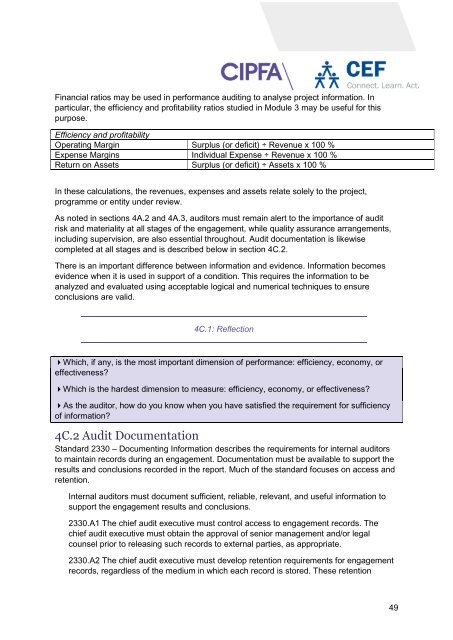Module 4 - Introduction to Performance Audit_4C
Create successful ePaper yourself
Turn your PDF publications into a flip-book with our unique Google optimized e-Paper software.
Financial ratios may be used in performance auditing <strong>to</strong> analyse project information. In<br />
particular, the efficiency and profitability ratios studied in <strong>Module</strong> 3 may be useful for this<br />
purpose.<br />
Efficiency and profitability<br />
Operating Margin Surplus (or deficit) ÷ Revenue x 100 %<br />
Expense Margins Individual Expense ÷ Revenue x 100 %<br />
Return on Assets Surplus (or deficit) ÷ Assets x 100 %<br />
In these calculations, the revenues, expenses and assets relate solely <strong>to</strong> the project,<br />
programme or entity under review.<br />
As noted in sections 4A.2 and 4A.3, audi<strong>to</strong>rs must remain alert <strong>to</strong> the importance of audit<br />
risk and materiality at all stages of the engagement, while quality assurance arrangements,<br />
including supervision, are also essential throughout. <strong>Audit</strong> documentation is likewise<br />
completed at all stages and is described below in section <strong>4C</strong>.2.<br />
There is an important difference between information and evidence. Information becomes<br />
evidence when it is used in support of a condition. This requires the information <strong>to</strong> be<br />
analyzed and evaluated using acceptable logical and numerical techniques <strong>to</strong> ensure<br />
conclusions are valid.<br />
<strong>4C</strong>.1: Reflection<br />
Which, if any, is the most important dimension of performance: efficiency, economy, or<br />
effectiveness?<br />
Which is the hardest dimension <strong>to</strong> measure: efficiency, economy, or effectiveness?<br />
As the audi<strong>to</strong>r, how do you know when you have satisfied the requirement for sufficiency<br />
of information?<br />
<strong>4C</strong>.2 <strong>Audit</strong> Documentation<br />
Standard 2330 – Documenting Information describes the requirements for internal audi<strong>to</strong>rs<br />
<strong>to</strong> maintain records during an engagement. Documentation must be available <strong>to</strong> support the<br />
results and conclusions recorded in the report. Much of the standard focuses on access and<br />
retention.<br />
Internal audi<strong>to</strong>rs must document sufficient, reliable, relevant, and useful information <strong>to</strong><br />
support the engagement results and conclusions.<br />
2330.A1 The chief audit executive must control access <strong>to</strong> engagement records. The<br />
chief audit executive must obtain the approval of senior management and/or legal<br />
counsel prior <strong>to</strong> releasing such records <strong>to</strong> external parties, as appropriate.<br />
2330.A2 The chief audit executive must develop retention requirements for engagement<br />
records, regardless of the medium in which each record is s<strong>to</strong>red. These retention<br />
49
















